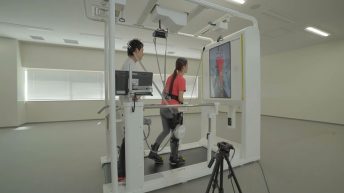The VEX exoskeleton is designed by Hyundai Motor Group for industrial workers who are working in overhead environments, such as fitting parts to the underside of vehicles. Last year the company launched another industrial wearable robot called CEX (the Chair Exoskeleton).
According to DongJin Hyun “VEX gives workers greater load support, mobility, and adaptability when operating in overhead environments.”
The VEX exoskeleton is lightweight and mimics the movement of human joints, allowing for added load support and mobility.
Hyundai Motor Manufacturing Alabama (HMMA), the automaker’s Montgomery plant, participated in the prototype trials and provided valuable feedback in the development of both VEX and CEX.
Though there are other exoskeleton products on the market, Hyundai believes its technology is better because it is lighter (5.5 pounds, which is 22-42% less than competitors) comfortable (worn like a backpack), adjustable (up to 7 inches in added length, up to 12.1 pounds in force assistance) and more affordable (expected to sell for 30% less than the typical $5,000 average of similar products).
Hyundai plans to target the VEX at production-line workers whose job is primarily overhead.
Hyundai Rotem is expected begin production of VEX in December and an HMMA spokesman said the Montgomery plant will be among its first customers.
Adding to its range of robotics technologies, Hyundai also plans to products CEX, which supports workers to maintain a sitting position without a stool or chair.
Hyundai said it has plans for other robotics technology, such as a ‘Hotel Service Robot,’ ‘Sales Service Robot,’ ‘Electric Vehicle Charging Manipulator’ and other ‘Robotic Personal Mobility’ solutions in the future.
Article Source:
http://www.koreatimes.co.kr/www/tech/2019/09/693_275084.html
https://www.stuff.co.nz/motoring/115535530/hyundai-heads-into-wearable-robots-sort-of
https://alabamanewscenter.com/2019/09/04/workers-at-hyundais-alabama-plant-to-use-new-wearable-robot-exoskeleton/

